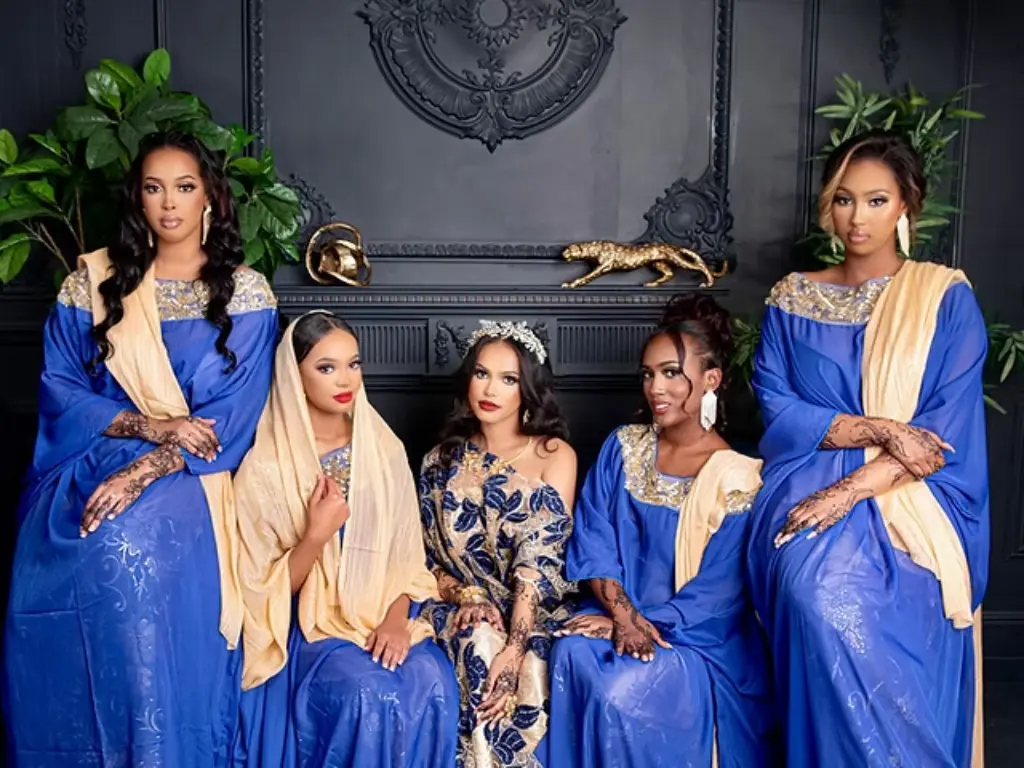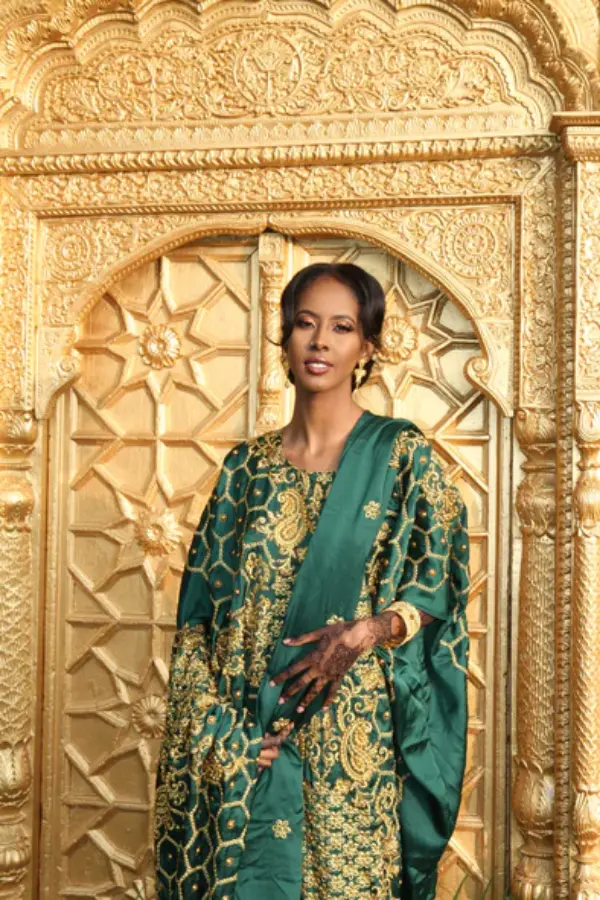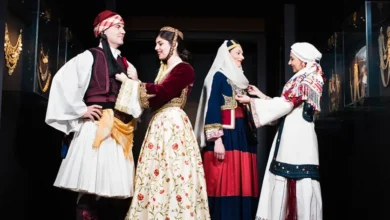The Somali Dirac dress is more than just clothing; it’s a vibrant symbol of culture, heritage, and identity. Particularly prominent in weddings and other celebratory rituals, the dirac is a garment that tells a story of tradition, artistry, and the enduring spirit of the Somali people. This article will explore the intricacies of the dirac, its significance, and its role in important life events.
Understanding the Dirac
The dirac is a long, flowing garment, typically made of a light, often sheer fabric such as chiffon, silk, or georgette. It is characterized by its loose fit and is usually worn over a slip or a light, complementary dress called a ‘gorgorad.’
The term ‘dirac’ itself is derived from the Arabic word for veil, which hints at its historical roots and the influence of Islamic culture on Somali traditions. While modest in its design, the dirac dress is anything but simple; its beauty lies in the richness of its embroidery and its use of vibrant colors.

Key Features of the Dirac
- Fabric: The choice of fabric contributes significantly to the dirac’s aesthetic. Lightweight, flowing fabrics allow for graceful movement, which is particularly important during celebrations.
- Embroidery: The intricate embroidery, often done by hand, is a hallmark of the dirac. This artistry is a testament to the skill of Somali artisans, and each design is often unique, adding a personal touch to the garment. Common motifs include floral patterns, geometric shapes, and traditional Somali designs.
- Colors: While a wide array of colors can be used, bright hues like gold, silver, red, blue, and green are popular choices, especially for celebratory occasions. These colors not only enhance the garment’s beauty but also hold symbolic meanings, reflecting joy, prosperity, and the cultural heritage.
- The Gorgorad: The underdress, or ‘gorgorad,’ is typically a plain, often neutral-colored, lightweight dress that provides coverage and allows the dirac to drape gracefully.
The Dirac in Somali Weddings
Perhaps the most prominent setting where the Somali Dirac dress shines is in Somali weddings. Here, it is not just a piece of clothing but a symbol of the bride’s beauty, the family’s pride, and the joining of two families. The dirac is carefully selected, often taking months to create, with particular attention given to the embroidery, fabric, and colors.
See also The Symbolism of the Huipil in Mexican Religious Ceremonies
The Symbolism of the Huipil in Mexican Religious Ceremonies
The Bride’s Dirac
The bride’s dirac is typically the most elaborate and intricate of all those worn at the wedding. It is a statement piece, designed to make her feel like the center of attention. The colors chosen for the bride’s dirac can vary, but gold and silver are common choices, symbolizing wealth and prosperity.
The embroidery is usually very detailed and may include family symbols or patterns that are significant to her lineage. The bride might wear several different diracs throughout the various ceremonies of the wedding, each one carefully chosen to reflect the solemnity and joyousness of the occasion.
Dirac at the Wedding Celebrations
Beyond the bride, female guests at a Somali wedding also often wear diracs, although typically less elaborate than the bride’s. The diracs worn by guests contribute to the vibrant and colorful atmosphere of the event. This collective display of the dirac signifies unity, cultural pride, and the importance of the community coming together to celebrate this important milestone. The dirac dress unites all the women in attendance in shared tradition.
The Dirac in Other Celebratory Rituals
While weddings are a primary occasion for showcasing the Somali Dirac dress, it is also a cherished garment for other celebratory events. These events highlight the dirac’s versatility and its continued role in marking significant moments in Somali life.
See also The Turkish Kaftan in Ottoman-Inspired Wedding Ceremonies
The Turkish Kaftan in Ottoman-Inspired Wedding CeremoniesEid Celebrations
During the Eid holidays, the dirac is a common sight, worn by women to attend prayers and family gatherings. These diracs, while often still vibrant, might be less elaborate than those worn at weddings. The use of the dirac during Eid underscores its role as a symbol of religious observance and communal celebration.
Cultural Festivals and Performances
The dirac dress is often worn during cultural festivals and traditional Somali performances. Its flowing silhouette and vibrant colors make it ideal for dance and performance, adding to the visual spectacle. In these settings, the dirac becomes a powerful symbol of Somali cultural identity, reinforcing its importance in the community.
Family Gatherings and Special Occasions
Even for less formal but important family gatherings, such as birthdays, anniversaries, or welcoming a new baby, the dirac is a popular choice. It adds a touch of elegance and tradition to these events, reinforcing the importance of family and heritage. This usage underscores the dirac’s place as a garment for special occasions and everyday cultural expression.
The Artistry and Craftsmanship Behind the Dirac
The creation of a Somali Dirac dress is a labor of love, often involving skilled artisans who have perfected their craft over generations. The process, particularly the embroidery, is both time-consuming and requires a high degree of skill. Traditional embroidery techniques are passed down through families, ensuring the continuity of this important cultural practice.

Hand Embroidery and Design
Much of the intricate embroidery on diracs is done by hand, using fine threads and tiny needles. The designs range from simple geometric patterns to complex floral motifs, reflecting a blend of traditional Somali aesthetics with contemporary influences. The embroidery on the dirac is not just decoration but a form of storytelling, with each stitch and pattern carrying cultural meaning.
The Role of Artisans
Local artisans, particularly women, play a central role in creating diracs. They are often specialists in particular embroidery styles or types of designs. These artisans are not just craftspeople; they are keepers of cultural heritage, ensuring that the art of making diracs remains alive and vibrant.
Evolution of the Dirac
While rooted in tradition, the Somali Dirac dress has evolved over time. Modern influences, such as new materials and embroidery techniques, have been incorporated into the dirac, reflecting the changing times while still retaining its cultural significance. This adaptability is part of the dirac’s enduring appeal.
Contemporary Styles
Contemporary dirac designs often feature new embellishments, such as sequins, beads, and lace, while maintaining the fundamental structure and silhouette. Designers have also experimented with different fabrics and color combinations, allowing the dirac to adapt to contemporary fashion trends.
This shows that the dirac, like all cultural garments, is a living tradition. The ability of the dirac dress to adapt to contemporary fashion while remaining true to its roots underscores its enduring value.
The Importance of Preservation
Efforts to preserve the traditional craftsmanship associated with the dirac are crucial for maintaining Somali cultural heritage. Initiatives aimed at training new generations of artisans and supporting local craft businesses help ensure that the art of dirac making continues for years to come. It is vital for cultural institutions to promote and celebrate the dirac through cultural events and exhibitions.
The Dirac as a Symbol of Identity

Beyond its aesthetic beauty and practical use, the Somali Dirac dress is a powerful symbol of Somali identity. It represents a link to the past, a celebration of the present, and a hope for the future. For many Somali women, wearing the dirac is a way of expressing their cultural pride and their connection to their roots. It is a tangible expression of belonging and community.
A Link to Heritage
Wearing the dirac connects Somali women to their history and traditions. It is a reminder of their cultural lineage and the generations of women who came before them. It carries with it a sense of continuity and cultural memory. The dirac dress allows every wearer to connect with a collective heritage.
Cultural Pride and Self-Expression
The dirac allows Somali women to express their individuality while also affirming their collective identity. The choice of colors, embroidery, and fabric is a personal expression of taste and style, yet it is always within the framework of Somali cultural norms. This balance of individual expression and collective identity makes the dirac a unique and important cultural garment.
Diaspora and the Dirac
For Somali communities in the diaspora, the dirac holds particular significance. It is a way of preserving and celebrating their cultural heritage while living in different parts of the world. It is worn at special events, cultural festivals, and religious gatherings, reinforcing a sense of identity and connection with their homeland. The dirac dress serves as a powerful symbol of cultural identity in the diaspora, helping to maintain connections to Somali heritage despite geographical distance.
The Somali Dirac dress is a testament to the beauty, resilience, and rich cultural heritage of the Somali people. From weddings to Eid celebrations, it remains a cherished garment that embodies tradition, artistry, and a profound sense of identity.
As time goes on, the dirac continues to adapt and evolve, while remaining true to its cultural roots. Its enduring presence and versatility underscore its value as a symbol of Somali identity and cultural expression. Its beauty lies not only in its intricate design, but also in the stories it tells and the traditions it embodies. This flowing garment is a vital piece of Somali culture, a symbol of unity, pride, and celebration.




